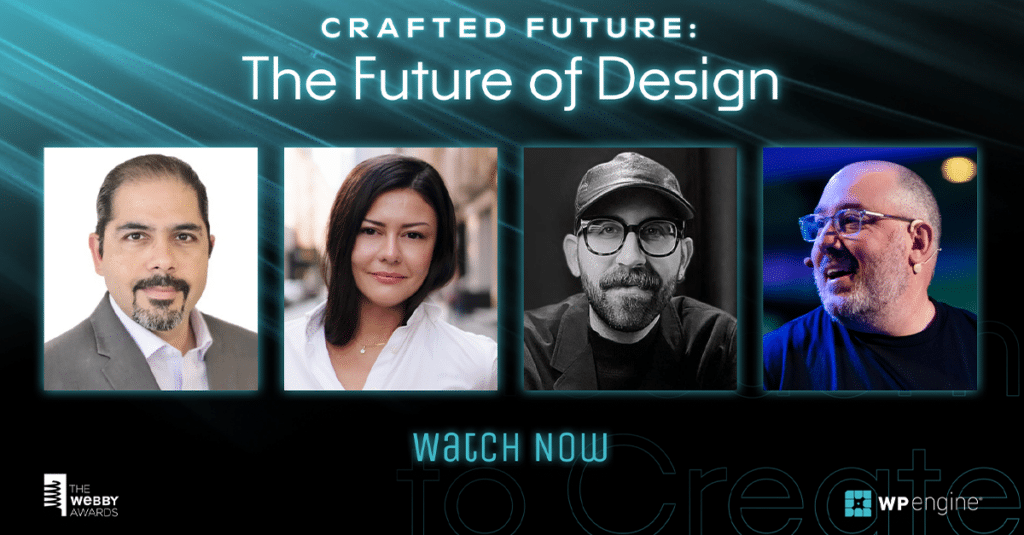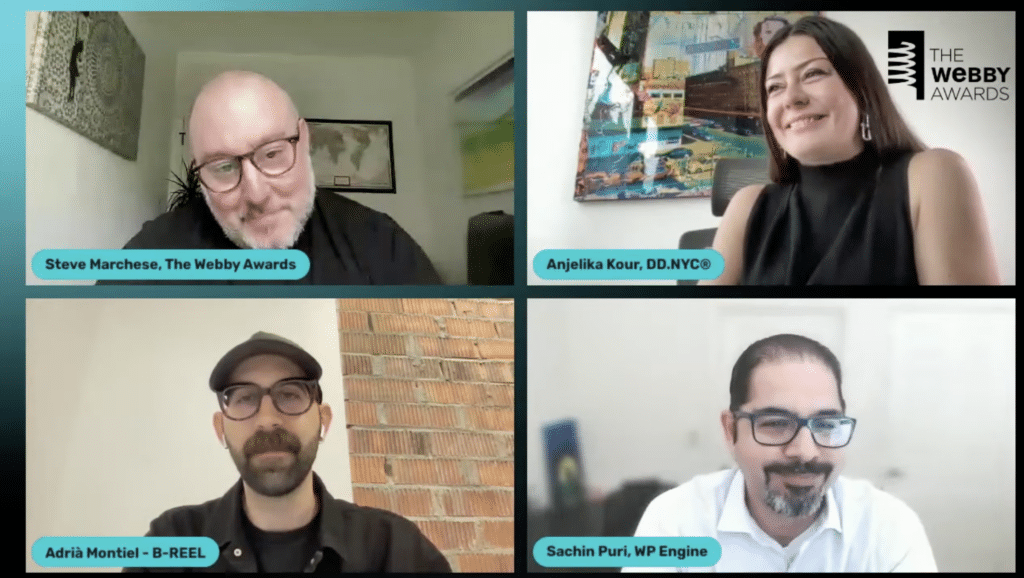
Artificial Intelligence and Headless Lay the Foundation for the Future of the Web
WP Engine CMO Sachin Puri shares five AI tips for designers during The Webbys Crafted Future panel
As Artificial Intelligence (AI) and headless technologies rapidly become more prevalent in modern web development, exciting innovations are fostering greater creative potential than ever before.
Those innovations were on full display as WP Engine CMO Sachin Puri joined DD.NYC Founder and Managing Director Anjelika Kour as well as B-REEL Product Design Lead Adrià Montiel for the online event Crafted Future: The Future of Design.
Partners since 2018, WP Engine and The Webby Awards co-created the annual Crafted with Code program to showcase the stories behind Webby-award winning sites. These extraordinary sites, how they were built, and the digital luminary leaders behind them are featured in a special section of the Webby’s site, and select leaders are also featured in an annual online panel event series, Crafted Future, discussing the latest in online trends.
The Future of Design was the third in the series and moderated by The Webby Awards Chief Production Officer Steve Marchese. The panel discussion focused on the current state of web design and the ways AI and agile tech will change the future of design work.

In our fast-paced digital world, designers and developers must rapidly create and deliver sites that excite and engage users, all while keeping in mind the growing need for omnichannel experiences.
This challenge opened the discussion. When asked how the work designers and developers do today has been transformed in recent years, the panelists had much to say.
“The turning point for the internet can be defined as the moment when it shifted from being a purely informational tool to a unique platform that changed how we work and how we interact,” Montiel said.
“In recent years, the work of designers and developers has transformed significantly due to the increased demand for their products and services. In the end, this has led to the need for a more agile and collaborative approach to product development as well as an increased focus on user experience,” he added.
While the other panelists agreed that the demand and pace of their work had expanded substantially in recent years, they also expressed an enthusiasm for diving into the advances in technology that have come with rapid digital transformation.
“I think it’s a really exciting time,” said Puri. “We’ve truly become multi-platform.
“Back in the day, it was all TV, then TV moved to PC, and PC moved to smartphone. Now we’re talking about IoT, we’re talking about AR, VR, and Metaverse. While it was easier to dismiss these technologies when they were still up-and-coming, customers are now omnichannel at any given point, with at least two screens, and so it’s become far more important for marketers to have strategies that cut across different platforms.”
Designing for Today’s Internet
Panelists also had thoughts on what it means to design for “today’s internet.”
Kour shared her thoughts on emerging tools and how they are impacting the workflows of today’s developers and designers.
“When the pandemic happened, we all had to collaborate in a unique new way—only digitally. So with designers and creatives having to now work with these digital tools, it’s yet another paradigm shift,” she said.
“These tools aren’t replacing creatives, but rather helping creatives realize a vision forward.”
Questions surrounding the emergence of headless site architecture piqued the interest of Puri, who expounded on the ways headless sites are already improving workflows between development and design.
“On headless, the customers are multi-channel, so the ability to think about, from a design standpoint, that you’re developing, designing, and creating once, and using that across different surfaces, is a key important skill set,” he said.
“That’s the beauty of decoupled architecture: Designers and creatives keep the flexibility and the knowledge base they’ve built while leveraging the power of the front end to deliver what the customer needs,” he added.
Puri further explained how decoupled, or headless architecture stands to benefit web designers in the future—even as AI takes on a larger role—offering them a widely extensible canvas on which they can build.
“From my standpoint, multi-channel ability is something which will natively start to develop in designers,” he said. “AI can help take that design into different forms, but headless is the vehicle on which you build because you want that power and flexibility from the development side without losing creativity.”
AI Empowers Creative Design
As the line of questioning veered away from headless development and deeper into AI, panelists shared the ways in which AI has already infiltrated the design process and looked toward a future in which AI empowers designers to create new projects more quickly and creatively.
“One of my colleagues always says, ‘it’s easier to edit than to build from scratch,’ so it gives you that initial start for your first draft, and then you can build from there,” Puri said.
“With AI, you have this live partner you can ideate with, and that’s massive… From a creative exploration standpoint, there’s no limit to it. So the co-creation aspect of AI is something that I would say we should adopt and embrace wholeheartedly.”
Puri also offered direct advice as to how AI can help the design and development process, citing five key areas where it can—and should—be applied:
- Automation: if you do it more than twice, automate it (e.g. image resizing, background change)
- Co-creation: it’s not AI or us, it’s AI and us, together
- Analysis and Q&A: e.g. monitoring live performance impacts and ADA requirements while designing
- Creativity: using AI to expand and ideate further (e.g. personalization)
- Designer & Developer Experience: e.g. speaking to AI (voice to text) when you have an idea, so you can write a code from a treadmill or while on a hike
Looking to the Future
As the discussion came to a close, the panel was asked what changes and challenges they foresee as these new tools and technologies continue to make their way into modern design and development workflows.
Panelists’ answers ranged from identifying the emerging challenges designers will face to their optimistic outlooks for increasing creativity across channels.
The matter of AI ethics has been top-of-mind amid growing concern from builders and technology experts who believe recent advancements are beginning to outpace the public’s ability to discern AI from reality. This has even prompted more than 1,000 signatories to sign an open letter that calls on all AI labs to pause their development for at least six months, providing government entities time to pass regulations that can mitigate the risk of AI-powered disinformation online.
“The last piece which we will all see evolve, though, is the aspect of ethics,” Puri said. “Where do you draw the line ethically in this nuanced conversation and where do we draw new regulations and standards?
“It’s going to be an interesting space. Advertising has already been transformed completely from what it was 10 years ago, and digital experiences built with AI will continue to disrupt those traditional processes.”
Kour then shared her final thoughts with the hope that these new tools will help designers further personalize experiences for users.
“When designers come up with new ideas, they often don’t come up with one, they’re coming up with multiple,” she said. “And sometimes they get attached to a version that the client doesn’t go with.
“And with the idea of personalization,” she continued, “having so many different channels and outlets for your art—it’s actually beautiful, because different ideas can be implemented and tested… The creative mindset doesn’t have to be so rigid anymore—that’s, I think, the beauty of the multi-channel environment and the personalization [capabilities] within all those channels.”
We extend our gratitude to all who joined us for this event and hope the insights shared during the discussion make you excited about using emerging technologies like headless development and AI for your next project.
Start the conversation.